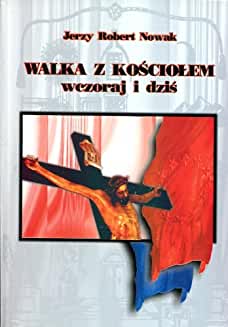Cultural Marxism Wars Against Catholic Church Nowak

Walka Z Kosciolem Wczoraj i Dzis, by Jerzy Robert Nowak. 1999
A Broad-Based Analysis of the Cultural Marxist Aggression Against the Catholic Church in Poland (and, Earlier, Mexico)
THE WAR AGAINST THE CHURCH YESTERDAY AND TODAY is the title of this fact-filled Polish-language work noted historian Jerzy Robert Nowak. WARNING: Its content is sobering and disturbing, and the sensitive reader is advised to avoid this book.
THE CRISTERO REBELLION
In the 1920’s and 1930’s, Mexico was ruled an anti-Christian government that heavy-handedly suppressed the Catholic Church. Nowak cites Frank Brandenburg, a leading historian of Mexico, who pointed out that the leading presidents of Mexico (Madero, Gil, Rubio, etc.) were high-ranking Freemasons. (p. 59).
A small group of anti-Christian elitists thus ruled over the mostly-religious Mexicans. (p. 66). In what became known as the Cristero Rebellion, the Mexican people rose up and took Mexico back from the secularists. Nowak’s account is inspiring, and the Cristero Rebellion may serve as a model for how Poland’s Catholics today could take Poland back from the cultural Marxists.
THE SPANISH CIVIL WAR
Nowak cites the scholarly work of Hugh Thomas. The latter points out that the liberal (Republican) government, which was anti-religious, was heavily influenced by Freemasonry. (p. 85).
During the attempted Communist takeover of Spain, the Republican forces made the destruction of Catholicism a top priority. Their militant atheism knew no bounds. For example, they burned almost all the churches of Barcelona, and engaged in mass burnings of Catholic libraries and paintings of saints. In all, over 20,000 churches were burned, comprising almost half of all of Spain’s churches. (p. 89).
SOVIET COMMUNISM
In the Soviet Union, in 1917-1985, the Communists murdered 200,000 clergy of various religions, including at least 130 Eastern Orthodox bishops. In addition, over 300,000 clergy were imprisoned. (p. 5, 11).
After the Nazi-Soviet conquest of Poland (1939), and especially after the Churchill-Roosevelt betrayal of Poland, and the giveaway of Poland’s eastern half (the Kresy) to the USSR at Teheran in 1943, the Communists systematically destroyed or closed almost all Polish churches. (pp. 50-on.).
Of the post-WWII Soviet-imposed puppet governments of Eastern Europe, the one in Albania was the most aggressively repressive of religion. (pp. 152-153). In subjugated Poland, Cardinal Stefan Wyszynski courageously defied the Communist establishment, proclaiming that he feared no one except God. (p. 194).
SUSTAINED ATTACKS ON THE CATHOLIC CHURCH TODAY
Cultural Marxism is on the warpath. The LEWACTWO and secularists, in Poland, would like to turn Poland’s Catholics into a minority that has been bullied into silence through marginalization, “separation of church and state” propaganda, and slanderous attacks. (p. 289, 301, 305). [Since Nowak wrote this book in 1999, this trend has accelerated. Think, for example, of KLER.]
There have been numerous desecrations and arsons of Catholic Churches in Poland, as well as assaults on Catholic priests. These have gotten very little attention, while vandalism of synagogues has gotten a great deal of publicity in the mainstream media. (p. 289).
THE DEMONIZATION OF RADIO MARYJA
Jerzy Robert Nowak elaborates on the reasons that RADIO MARYJA is so feared and hated by secularists and leftists (including the Katolewica–the Catholic Left). There are many such reasons.
The Katolewica tends towards postmodernism, moral permissiveness, and moral relativism, and is allied with atheists. (p. 307). RADIO MARYJA stands for traditional morality, and threatens the political Left tending to lift people out of their moral ignorance and lethargy (p. 309), and becoming a focal point for those Poles who support traditional morality. (p. 310).
The Polish Left uses the same scare tactics as the American Left, notably the bogeyman of “the danger of theocracy” (p. 332) and “talibanism”. It also accuses RADIO MARYJA of being divisive. (This is doubly ironic since the Left has always specialized in dividing people, as into arbitrary and self-serving classes of “victims” and “oppressors”.)
RADIO MARYJA is a threat to Poland’s mainstream media, which tends to be indifferent or hostile to Polish patriotism. As of 1995, 70% of Poland’s media was foreign-owned (often under Polish names), according to Father Tadeusz Rydzyk, and this is a loss of Polish sovereignty and a form of neo-colonialism against Poland. (pp. 310-311). Any competitor with this monopoly is a threat in itself.
Poland’s Communists and ex-Communists are also threatened by RADIO MARYJA. This is because its programs often remind the Poles of the crimes of the Communists, and the fact that these have never been punished, owing to the GRUBA KRESKA (“thick line”) policy and the lack of LUSTRACJA. (pp. 316-317). Some notable enemies of RADIO MARYJA were post-Communists such as President Kwasniewski and Jerzy Urban. (p. 332).
Politicians are threatened by RADIO MARYJA. This owes to the fact that listeners to RADIO MARYJA tend to vote at higher frequency than non-listeners. (p. 319). In addition, RADIO MARYJA opposes the policies of the former nomenklatura, especially the privatization of Polish industry while selling it for a very low price. (p. 323).
To see a series of truncated reviews in a Category click on that Category:
- All reviews
- Anti-Christian Tendencies
- Anti-Polish Trends
- Censorship on Poles and Jews
- Communization of Poland
- Cultural Marxism
- German Guilt Dilution
- Holocaust Industry
- Interwar Polish-Jewish Relations
- Jewish Collaboration
- Jewish Economic Dominance
- Jews Antagonize Poland
- Jews Not Faultless
- Jews' Holocaust Dominates
- Jews' Holocaust Non-Special
- Nazi Crimes and Communist Crimes Were Equal
- Opinion-Forming Anti-Polonism
- Pogrom Mongering
- Poland in World War II
- Polish Jew-Rescue Ingratitude
- Polish Nationalism
- Polish Non-Complicity
- Polish-Ukrainian Relations
- Polokaust
- Premodern Poland
- Recent Polish-Jewish Relations
- The Decadent West
- The Jew as Other
- Understanding Nazi Germany
- Why Jews a "Problem"
- Zydokomuna